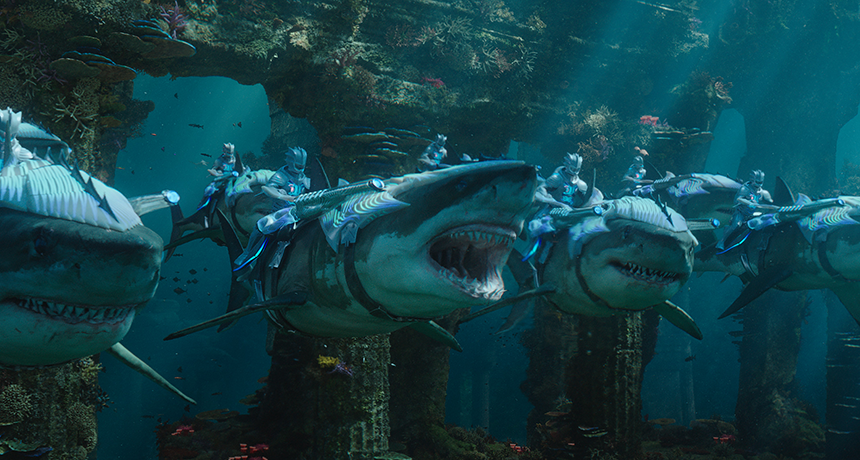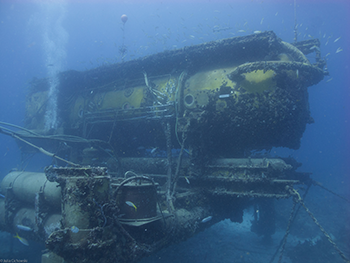What makes Aquaman special? He can take a lot of pressure
Here’s why people won’t be living under the sea anytime soon

Forget the giant sharks. Let’s talk about what that building behind them is made from.
Courtesy of Warner Bros. Pictures
Share this:
- Share via email (Opens in new window) Email
- Click to share on Facebook (Opens in new window) Facebook
- Click to share on X (Opens in new window) X
- Click to share on Pinterest (Opens in new window) Pinterest
- Click to share on Reddit (Opens in new window) Reddit
- Share to Google Classroom (Opens in new window) Google Classroom
- Click to print (Opens in new window) Print
Sure, the new Aquaman movie has big toothy sea monsters. It’s got glowing tridents and a hero who can lift an entire submarine. But it’s the city of Atlantis that really steals the show. Named after the mythical metropolis that collapsed into the ocean, Atlantis here is an entire underwater kingdom. Whales swim by glowing, disk-shaped buildings. These newer structures rise above old ruins, stacking up like a huge coral reef made of condos.
It’s enough to make anyone wish for life under the sea. But while that underwater life looks peaceful, it comes with a lot of pressure. (And not just because you might be fighting for your life against your half-brother and his attempts to take over the world.) All that water weighs heavy upon a person, fish or Atlantean building. And that requires some special adaptations to survive.
Above water, you — and everything on the planet — are under a bit of pressure. Air has mass, and that mass presses down. At sea level, the column of air above you presses down with a force of about 1 kilogram per square centimeter (14.5 pounds per square inch). That is about the weight of a 3-month-old baby on every square inch. It might sound heavy, but you don’t notice it because your body is used to this pressure.
Climb to the top of a mountain and there will be less air above you. That reduced mass means there is less pressure. But dive into the ocean, sink down, and you’ll quickly discover what real pressure is.
Pushing down on me, pushing down on you
Water is heavier than air. The farther you sink below the surface, the more water that weighs down on you. Every 10 meters (or 33 feet) of depth adds another 6.6 kilograms per square centimeter (14.5 pounds per square inch) of pressure.
“If you took an empty plastic water bottle and went down 75 feet [22 meters], it would be crushed flat,” notes George Elvin. He works at North Carolina State University in Raleigh. There, he studies how people can build structures in extreme environments — underwater, for instance.
People are a bit tougher than empty plastic water bottles, of course. But they’re not indestructible. “The deepest human dive unprotected is about 1,000 feet,” Elvin says. That’s about 300 meters. At this depth, the body is experiencing 100 times the pressure it experiences at the surface. At deeper depths, Elvin explains, there’s so much pressure that any sack of air in your body — such as your lungs — would simply collapse. If your lungs don’t expand, you don’t breathe. Nice knowing you.

Most people live on dry ground, but there are a few who live underwater for short periods — well within those tolerable limits. Even then, though, they require time to adjust, notes Roger Garcia. He’s the operations director of the Aquarius Reef Base. It’s an underwater habitat where scientists can live for a few days at a time while they study the ocean. It sits 15 meters (about 50 feet) below the surface of the Gulf of Mexico, off the western coast of Florida.
The inside of this facility is filled with air kept at the same pressure as the water outside. At that depth, Garcia says, it doesn’t really feel like the water is pressing in on all sides, and he’s got plenty of experience with it. There’s only one thing he notices. Because the gas is denser than at sea level, he notes, “most of the time your voice is a little bit deeper.” So hanging out in a shallow Atlantis would affect your singing voice, but that’s about it.
Returning to the surface, however, isn’t easy — even from such shallow depths. As someone swims to the surface, the pressure drops. This allows gases dissolved in the body to form bubbles. If those bubbles form in the blood or brain, they can cause joint aches. They can even burst vessels in the brain and rupture tissues in the lungs. This condition is known as decompression sickness (or sometimes, “the bends”).
Aquaman may not have this problem. But the rest of us are not so lucky. To avoid decompression sickness, people in Garcia’s reef base need to rise to the surface slowly. Rather than each person swimming, the base itself rises to the sea surface. The trip takes 15 hours, but it lets the people inside slowly adjust to the falling pressure and avoid those bubbles.
In an octopus’s garden
When dealing with underwater pressures, people often opt to build with circles. Garcia’s reef base, for example, is a giant steel tube. Submarines are also rounded metal tubes. Even better than a circle, though, is a sphere. “A sphere is the perfect shape for an underwater building or city,” Elvin says. Its round shape distributes pressure evenly across a structure. The disk-shaped structures of Aquaman’s Atlantis aren’t the absolute best design for underwater life, Elvin says, “but they get close.”
Withstanding pressure is especially important when people build underwater. Those structures have air inside that people need to breathe. “If there’s water inside, you’re set,” Elvin says. If the structure was filled with water instead of air, the pressure on the inside would be the same as the pressure outside. That makes building easy, but living there a lot harder.
Building underwater also requires different types of materials. Those used to build on land “wouldn’t work very well,” Elvin says. And pressure is just one problem. “An underwater environment is very harsh, with different chemicals in the water,” he notes. Wood rots. Steel rusts. The ocean can even break down some plastics.
Atlantean building materials might therefore be something a bit more natural. “Look at materials that are comfortable underwater and use those,” Elvin says. Calcium carbonate might be especially good. This chemical makes up the shells of organisms like mussels and corals.
In fact, Elvin notes, the director of Aquaman, James Wan, was inspired by coral reefs when he imagined the city of Atlantis. “It’s really intelligent and creative,” Elvin says. “[Wan] wasn’t thinking about how land-based buildings and cities would work underwater. He started underwater…looking at nature. We know the biggest structures on Earth are coral reefs. He’s sharp to think of that.”







